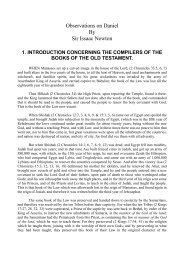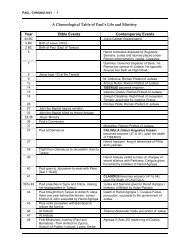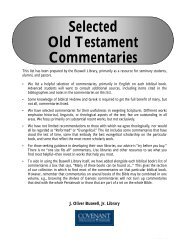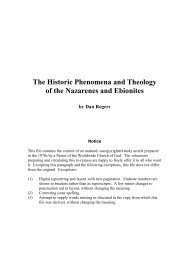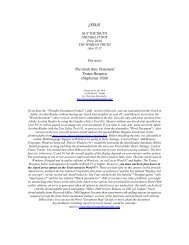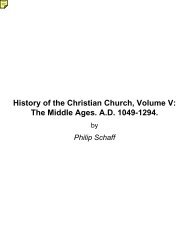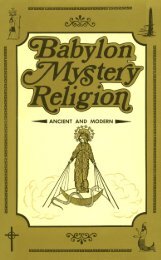by Percy E. Corbett - friendsofsabbath.org
by Percy E. Corbett - friendsofsabbath.org
by Percy E. Corbett - friendsofsabbath.org
You also want an ePaper? Increase the reach of your titles
YUMPU automatically turns print PDFs into web optimized ePapers that Google loves.
25<br />
Caractacus alone was subject to the parole. It was not required of any of the other royal<br />
captives. They were free to leave Rome if they desired. The first to leave were his eldest and<br />
youngest sons, Cyllinus and Cynon. Cyllinus returned to Britain to rule and act as regent in the<br />
absence of his father. Cynon entered the Silurian theological university.<br />
The trial of Caractacus took place in A.D. 52. St. Peter went to Rome in A.D. 44. According to<br />
St. Jerome, St. Paul went to Rome in A.D. 56. So the establishment of a Christian community<br />
in the Palace of the British coincided with the visits of the Apostles.<br />
In A.D. 53, another important event took place. Caractacus had two daughters, Eurgain the<br />
eldest, and Gladys. Emperor Claudius so admired the character and beauty of Gladys that he<br />
adopted her as his own daughter. She took his name and became known as Claudia. In her<br />
teens she was betrothed and she married Rufus Pudens Pudentius in A.D. 53.<br />
Pudens, as he was most commonly called, was a Roman senator and formerly personal aidede-camp<br />
to Aulus Plautius. As such he came to Britain in A.D. 42 and there is still a 'Pudens'<br />
stone at Chichester. The inscription on the stone reads:-<br />
"The College of Engineers, and ministers of religion attached to it, <strong>by</strong> permission of Tiberius<br />
Claudius Cogidunus, the king, legate of Augustus in Britain, have dedicated at their own<br />
expense in honour of the divine family, this temple to Neptune and Minerva. The site was given<br />
<strong>by</strong> Pudens, son of Pudentinus."<br />
Ge<strong>org</strong>e Jowett writes that their marriage was performed <strong>by</strong> the Christian pastor, Hermas, (who<br />
is. mentioned in Romans 16: 14) in the palace of the British. Caractacus gave them the palace<br />
as a wedding gift and, although Pudens was a wealthy man owning vast estates in the Umbria<br />
region, they chose to live at the Palace. The Roman Martyrology records that he brought his<br />
servant staff from Umbria, numbering two hundred men and two hundred women.<br />
Adjoining the Palace were two magnificent baths the largest in Rome. They were named after<br />
the children of Claudia and Pudens, and were known as Thermae Timotheus and Thermae<br />
Novatianae.<br />
Pastor Hermas refers to the Palace as 'Amplissimus Pudentis domus' the 'hospitium or home<br />
of hospitality.' For many years it was a sanctuary for Christians wherein no Roman soldier<br />
dare set foot to arrest any member or guest of the Pudens household.<br />
In addition to their sons, Claudia and Pudens had two daughters, Pudentiana and Praxedes.<br />
Ge<strong>org</strong>e Jowett writes that their son Timotheus was named after St. Timothy, Bishop of<br />
Ephesus. The Roman Martyrologies record that the children of Claudia were brought up at the<br />
knee of St. Paul.<br />
Another event of great importance took place in A.D. 58 when Linus, son of Caractacus, was<br />
personally consecrated <strong>by</strong> St. Paul to be the first Bishop of the Christian Church in Rome. The<br />
church still stands in what was once the palatial grounds of the Palace of the British. It is<br />
known as St. Pudentiana in honour and memory of Claudia's martyred daughter.



